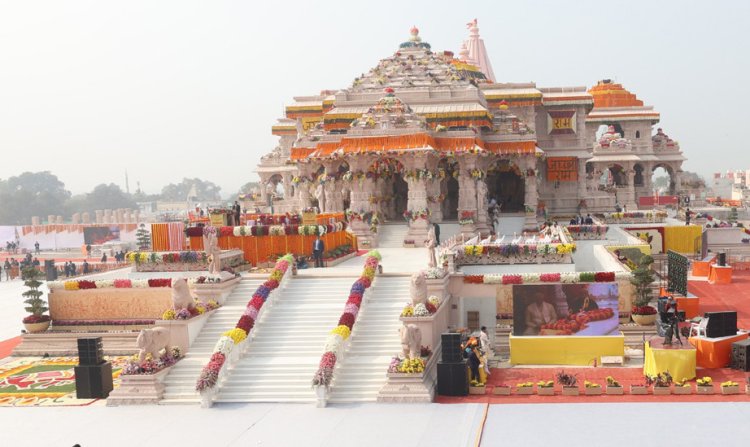The captivating beauty of Ayodhya's Ram Mandir
Explore the captivating beauty of Ayodhya’s Ram Mandir — a symbol of devotion, architecture, and Indian heritage. Discover its design, spiritual aura, and why it’s a must-visit destination.

Ayodhya's Shri Ram Janmabhoomi Temple is scheduled to be dedicated on January 22 in front of Prime Minister Narendra Modi and other dignitaries. With the consecration ceremony (pran pratishtha) of Ram Lalla in the sanctum-sanctorum (garbha-griha) coming up, the temple will be accessible to devotees starting on 19 January.
Intricate carvings depicting India's century-old history adorn the Ram Janmabhoomi temple, which is a sight to behold. Indeed, it is more than just a structure; it is a centuries-old treasure of faith and tradition that has been located in the centre of India. The architectural wonders and symbolic components of the holy building are highlighted in this article.
Ayodhya, a city deeply rooted in Hindu mythology and spirituality, has been at the heart of India's cultural consciousness for centuries. In recent years, the spotlight has returned to this sacred land with the construction of the **Ram Mandir** — a symbol of faith, devotion, and national pride. The beauty of the Ram Mandir is not only in its architecture but also in the spirit it represents. From the intricate carvings to the majestic structure, the temple is a modern marvel rooted in ancient traditions.
In this blog, we explore the captivating beauty of Ayodhya's Ram Mandir — its design, spiritual essence, cultural impact, and why it has become a must-visit destination for devotees and tourists alike.
A Grand Structure Rooted in History
The Ram Mandir is not just a place of worship — it is a monument that represents the aspirations of millions of Hindus worldwide. Built at the **Janmabhoomi** (birthplace) of Lord Rama, the temple stands on a site of historical, spiritual, and emotional significance.
The temple’s foundation was laid in August 2020, and the construction has since continued with tremendous public support and enthusiasm. Designed in the **Nagara style of Indian temple architecture**, the temple’s construction uses ancient techniques without the use of steel, staying true to traditional methods.
Features of Ram Mandir in Ayodhya
In 1988, the Sompura family from Ahmedabad created the initial plan for Ram Mandir. With regard to the Vastu and Shilpa shastras, it underwent some modifications in 2020. The Somnath temple is one of the more than 100 temples that the Sompuras have designed over the course of at least 15 generations.
Modern Facilities/Amenities in Ram Temple Premises
- Multipurpose Distribution and Operations Room
- Bank/ATM
- Essential Public Utilities (Toilets, Bathroom, Washroom & More)
- Emergency Medical Facilities
- Ramps/Lifts for Senior Citizens
- Solar Energy Panels and Power Back-Ups
- Pilgrim facility center
- Pilgrim/Visitor Management System
Architectural Brilliance of the Ram Mandir
The design and architecture of the Ram Mandir are nothing short of breathtaking. The temple is designed by the Sompura family, a group of architects with a 15-generation history of designing Hindu temples. Here are a few highlights of its architectural beauty:
1-Dimensions and Layout
- The temple measures **360 feet long**, **235 feet wide**, and **161 feet high**.
- It is a **three-storied** structure with five **mandapas** (porches) and a grand **shikhar** (spire) that rises above the sanctum.
- The temple complex includes **pavilions**, **shrines**, and **gardens**, creating a tranquil and serene environment.
2-Use of Materials
- Pink sandstone from Rajasthan has been used extensively for the temple’s construction.
- The marble used in the sanctum adds a royal touch and provides a peaceful ambiance for devotees.
3-Intricate Carvings
- The temple features **sculptures of deities**, floral patterns, mythological motifs, and scenes from the Ramayana.
- Each carving has been crafted by skilled artisans, giving the structure a rich and traditional look.
Features of Shri Ram Janmbhoomi Mandir
— Shri Ram Janmbhoomi Teerth Kshetra (@ShriRamTeerth) January 4, 2024
1. The Mandir is in the traditional Nagar style.
2. The Mandir has a length (east-west) of 380 feet, a width of 250 feet, and a height of 161 feet.
3. The Mandir is three-storied, with each floor being 20 feet tall. It has a total of 392… pic.twitter.com/Sp2BzzU5sv
Spiritual Vibes and Sacred Atmosphere
Walking through the temple complex, one can instantly feel the **spiritual energy** that surrounds the place. Chanting of mantras, the ringing of temple bells, and the fragrance of incense create an atmosphere of devotion and peace.
The **Garbhagriha (sanctum sanctorum)** houses the idol of **Ram Lalla** — the child form of Lord Rama — which is the main attraction of the temple. Devotees queue for hours to get a glimpse of the deity and seek blessings.
A Hub of Culture and Tourism
The Ram Mandir has not only revived the spiritual essence of Ayodhya but also given a major boost to **religious tourism**. Pilgrims from across India and even from abroad are now visiting Ayodhya to witness the temple's grandeur.
Several development projects are underway to enhance the city’s infrastructure, including new hotels, better transportation, and a more tourist-friendly environment.
Eco-Friendly and Sustainable Construction
What adds to the Ram Mandir’s beauty is its **eco-conscious** construction approach. The temple has been designed to last for more than **1,000 years**, using sustainable materials and techniques. There is also a focus on creating green spaces around the complex, with trees, water bodies, and gardens contributing to the overall peace of the environment.
Symbol of Unity and Devotion
The construction of the Ram anMdir has brought people from all walks of life together. Millions have contributed donations, volunteered for seva (service), and shared emotional moments connected to the temple. The project has become a **national symbol of unity, faith, and dedication**.
People see the temple not just as a religious monument, but as a representation of Indian culture, values, and spiritual history.
Best Time to Visit Ram Mandir
While Ayodhya welcomes visitors year-round, the best time to visit the Ram Mandir is during the **winter months** from **October to March**. The weather is pleasant, and several festivals, including **Ram Navami**, are celebrated with grandeur.
Devotees also prefer to visit during **Diwali**, as it is believed Lord Rama returned to Ayodhya on this day after 14 years of exile.
श्री राम जन्मभूमि मंदिर का भव्य सिंहद्वार
— Shri Ram Janmbhoomi Teerth Kshetra (@ShriRamTeerth) January 4, 2024
The Magnificent Sinh Dwar of Shri Ram Janmbhoomi Mandir.
????Ayodhya pic.twitter.com/1BhjPpJh2N
How to Reach Ayodhya
- By Air: The Maharishi Valmiki International Airport, Ayodhya (newly developed) connects the city with major metros.
- By Train: Ayodhya has a well-connected railway station, with trains from Delhi, Lucknow, Varanasi, and other cities.
- By Road: Regular buses and taxis operate from nearby towns and cities like Lucknow, Faizabad, and Gorakhpur.
Nearby Attractions to Explore
If you're planning a trip to the Ram Mandir, here are some nearby places to explore:
- Hanuman Garh: A temple dedicated to Lord Hanuman with panoramic views of Ayodhya.
- Kanak Bhawan: Known for its stunning interiors and deity idols of Rama and Sita.
- Saryu River Ghats: Perfect for an early morning boat ride or a peaceful evening aarti.
The built-up area of the Ram mandir is given in the below table
|
Total area |
2.7 Acres |
|
Total built-up area |
57,400 Sq.feet |
|
Total length of the temple |
360 feet |
|
Total width of the temple |
235 feet |
|
Total height of temple (including peak) |
161 feet |
|
Total floors |
3 |
|
Height of each floor |
20 feet |
|
No. of columns in ground floor |
160 |
|
No. of columns in first floor |
132 |
|
No. of columns in second floor |
72 |
|
No. of pavilions |
5 |
|
No. of gates in the temple |
12 |
Different zones and regions of Ram Mandir in Ayodhya
The 70-acre sacred area is the birthplace of Lord Rama. It contains a variety of mythologically significant passages. The Nritya, Colour, Sabha, Prayer, and Kirtan Pavilions are the names of the five pavilions that make up the main temple. Apart from this, the hallowed grounds are separated into:
|
Shri Ram Kund |
Yagyashala |
|
Karma Kshetra |
Anusthaan Mandap |
|
Hanuman Gadhi |
Veer Maruti Vishal Pratima |
|
Shri Ram Lala Purakalik Darshan Mandal |
Janmbhoomi Sangrahalaya |
|
Shri Kamm Keerti |
Satsang Bhawan Sabhagar |
|
Guru Vashistha Peethika |
Center of Study For Research |
|
Bhakti Teela |
Special Peace Zone |
|
Tulsi |
Ramleela Center/Open Theatre |
|
Ram Darbar |
Multifunctional Community Center |
|
Mata Kaushalya Vatsalya Mandal |
Exhibition Center |
|
Ramangan |
TV/Cinema/AV Based Show Theater |
|
Ramayan |
Library/Reading Room |
|
Maharshi Valmiki |
Archives & Research Center |
|
Ramashrayam |
Boarding/Lodging/Waiting Area |
|
Shri Dashrath |
Cow Shelter |
|
Laxman Vatika |
Lily Pond & Musical Fountain |
|
Lav Kush Nikunj |
Activity Area For Children |
|
Maryada Kunj |
Special Guest Residential Area |
|
Bharat-Prasad Mandar |
Bhog/Prasad Distribution Area |
|
Mata Sita Rasoi Annakshetra |
Large Food Shelter |
|
Deepstambh |
Lamp Tower in front of Singhdwar |
Final Thoughts
The captivating beauty of Ayodhya’s Ram Mandir lies not just in its physical form but in the **emotions, history, and faith** it represents. It is more than a temple; it is a **spiritual journey**, a **cultural revival**, and a **symbol of unity** for millions. Whether you are religious or simply appreciate heritage and architecture, a visit to the Ram Mandir is sure to leave you spellbound.
As the temple nears its full completion, the world watches Ayodhya transform into a **global center of devotion and culture**. If you haven’t already, it’s time to witness this timeless beauty in person.













